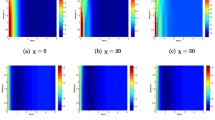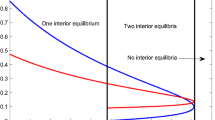Abstract
In this paper, we focus on the dynamical properties of a diffusive Lotka–Volterra system with fear effects subjected to the Neuman boundary condition in a bounded domain. The nonexistence of nonconstant solutions is obtained when diffusion rate is sufficiently large. We also establish the existence and multiplicity of the nonhomogeneous steady-state solutions bifurcating from the constant solution of the system by means of the Lyapunov–Schmidt reduction method. In addition, we consider the influence of the intrinsic growth rate on the population dynamics of the model and show that not only can the population density of both predator and prey change by changing the intrinsic growth rate, but also the coexistence equilibrium can possibly be destabilized. At the same time, we also consider the fear effect on the stability, we find that there is no obvious impact on the stability when the fear effect k is small. However, the results on stability will obviously change when the fear effect is large, which are very different from the ODE system (Wang et al. in J Math Biol 73:1179-1204, 2016) without the fear effect.
Similar content being viewed by others
References
Cantrell, R.S., Cosner, C.: Spatial Ecology via Reaction–diffusion Equations. Wiley, New York (2003)
Cantrell, R.S., Cosner, C., Hutson, V.: Permanence in ecological systems with spatial heterogeneity. Proc. R. Soc. Edinb. Sect. A 123(3), 533–559 (1993)
Chen, X., Hambrock, R., Lou, Y.: Evolution of conditional dispersal: a reaction–diffusion-advection model. J. Math. Biol. 57(3), 361–386 (2008)
Chen, X.Y., Polavcik, P.: Gradient-like structure and Morse decompositions for time-periodic one-dimensional parabolic equations. J. Dyn. Differ. Equ. 7(1), 73–107 (1995)
Du, Y., Lou, Y.: Qualitative behaviour of positive solutions of a predator-prey model: effects of saturation. Proc. R. Soc. Edinb. Sect. A 131, 321–349 (2001)
Gourley, S.A., Britton, N.F.: A predator–prey reaction–diffusion system with nonlocal effects. J. Math. Biol. 34, 297–333 (1996)
Hale, J.K.: Asymptotic Behavior of Dissipative Systems. Math. Surveys Monogr., vol. 25, Amer. Math. Soc., Providence, RI (1988)
Henry, D.: Geometric Theory of Semilinear Parabolic Equations. Lecture Notes in Math, vol. 840. Springer, Berlin (1981)
Guo, S.J., Ma, L.: Stability and bifurcation in a delayed reaction–diffusion equation with Dirichlet boundary condition. J. Nonlinear Sci. 26(2), 545–580 (2016)
Jiang, J., Shi, J.: Dynamics of a reaction–diffusion system of autocatalytic chemical reaction. Discrete Contin. Dyn. Syst. 21(1), 245–258 (2008)
Lam, K.Y., Ni, W.M.: Uniqueness and complete dynamics in heterogeneous competition–diffusion systems. SIAM J. Appl. Math. 72(6), 1695–1712 (2012)
Leung, A.: Limiting behaviour for a prey–predator model with diffusion and crowding effects. J. Math. Biol. 6, 87–93 (1978)
Li, D., Guo, S.: Stability and Hopf bifurcation in a reaction–diffusion model with chemotaxis and nonlocal delay effect. Int. J. Bifurc. Chaos. 4(28), 1850046 (2018)
Li, D., Guo, S.: Traveling wavefronts in a reaction–diffusion model with chemotaxis and nonlocal delay effect. Nonlinear Anal. Real World Appl. 45, 736–754 (2019)
Li, D., He, X., Li, X., Guo, S.: Traveling wavefronts in a two-species chemotaxis model with Lotka–Volterra competitive kinetics. Appl. Math. Lett. 114, 106905 (2021)
Ma, L., Gao, J.P., Li, D., Lian, W.Y.: Dynamics of a delayed Lotka–Volterra competition model with directed dispersal. Nonlinear Anal. Real World Appl. 71, 103830 (2023)
Ma, L., Guo, S.J.: Positive solutions in the competitive Lotka–Volterra reaction–diffusion model with advection terms. Proc. Am. Math. Soc. 149(7), 3013–3019 (2021)
Ma, L., Guo, S.J.: Bifurcation and stability of a two-species reaction–diffusion–advection competition model. Nonlinear Anal. Real World Appl. 59, 103241 (2021)
Ma, L., Feng, Z.S.: Stability and bifurcation in a two-species reaction–diffusion–advection competition model with time delay. Nonlinear Anal. Real World Appl. 61, 103327 (2021)
Merchant, S.M., Nagata, W.: Instabilities and spatiotemporal patterns behind predator invasions with nonlocal prey competition. Theor. Popul. Biol. 80, 289–297 (2011)
Mischaikow, K., Smith, H., Thieme, H.R.: Asymptotically autonomous semiflows: chain recurrence and Lyapunov functions. Trans. Am. Math. Soc. 347(5), 1669–1685 (1995)
Pao, C.V.: Nonlinear Parabolic and Elliptic Equations. Plenum Press, New York (1992)
Peng, R., Shi, J., Wang, M.: On stationary patterns of a reaction–diffusion model with autocatalysis and saturation law. Nonlinearity 21(7), 1471–1488 (2008)
Peng, R., Shi, J.: Non-existence of non-constant positive steady states of two Holling type-II predator-prey systems: Strong interaction case. J. Differ. Equ. 247, 866–886 (2009)
Pijush, P., Nikhil, P., Sudip, S., Joydev, C.: A three species food chain model with fear induced trophic cascade. Int. J. Appl. Comput. Math. 5(100), 1–26 (2019)
Suraci, J.P., Clinchy, M., Dill, L.M., Roberts, D., Zanette, L.Y.: Fear of large carnivores causes a trophic cascade. Nat. Commun. 7, 10698 (2016)
Tang, D., Zhou, P.: On a Lotka–Volterra competition-diffusion–advection system: homogeneity vs heterogeneity. J. Differ. Equ. 268(4), 1570–1599 (2020)
Tang, D., Chen, Y.M.: Global Dynamics of a Lotka–Volterra competition-diffusion system in advective heterogeneous environments. SIAM J. Appl. Dyn. Syst. 20(3), 1232–1252 (2021)
Ge, Q., Tang, D.: Global dynamics of two-species Lotka–Volterra competition–diffusion–advection system with general carrying capacities and intrinsic growth rates. J. Dyn. Differ. Equ. (accepted)
Wang, X., Zanette, L., Zou, X.: Modeling the fear effect in predator–prey interactions. J. Math. Biol. 73, 1179–1204 (2016)
Wu, J.H.: Theory and Applications of Partial Functional Differential Equations. Springer, New York (1996)
Ye, Q., Li, Z., Wang, M., Wu, Y.: Introduction to Reaction–Diffusion Equations. Science Press, Beijing (2011)
Yi, F., Wei, J., Shi, J.: Bifurcation and spatiotemporal patterns in a homogeneous diffusive predator-prey system. J. Differ. Equ. 246, 1944–1977 (2009)
Zanette, L.Y., White, A.F., Allen, M.C., Michael, C.: Perceived predation risk reduces the number of offspring songbirds produce per year. Science 334, 1398–1401 (2011)
Zhou, J., Mu, C.: Coexistence states of a Holling type-II predator–prey system. J. Math. Anal. Appl. 369, 555–563 (2010)
Acknowledgements
We sincerely thank the very detailed and helpful referee reports by the anonymous reviewers and helpful suggestions by the editors.
Author information
Authors and Affiliations
Corresponding author
Additional information
Publisher's Note
Springer Nature remains neutral with regard to jurisdictional claims in published maps and institutional affiliations.
L. Ma is supported by the NSFC (Grant Nos. 12161003, 12071446, 11801089) and Jiangxi Provincial Natural Science Foundation (Grant Nos. 20202BAB211003, 20224BAB211004). D. Li is supported by Scientific and Technological Research Program of Chongqing Municipal Education Commission (Grant NO. KJQN201900610), Natural Science Foundation of Chongqing, China (Grant No. CSTB2022NSCQ-MSX1204) and NSFC (Grant No. 12001076).
Rights and permissions
Springer Nature or its licensor (e.g. a society or other partner) holds exclusive rights to this article under a publishing agreement with the author(s) or other rightsholder(s); author self-archiving of the accepted manuscript version of this article is solely governed by the terms of such publishing agreement and applicable law.
About this article
Cite this article
Ma, L., Wang, H. & Li, D. Steady states of a diffusive Lotka–Volterra system with fear effects. Z. Angew. Math. Phys. 74, 106 (2023). https://doi.org/10.1007/s00033-023-01998-8
Received:
Revised:
Accepted:
Published:
DOI: https://doi.org/10.1007/s00033-023-01998-8
Keywords
- Reaction–diffusion system
- Fear effects
- Neumann boundary condition
- Stability
- Bifurcation
- Lyapunov–Schmidt reduction




